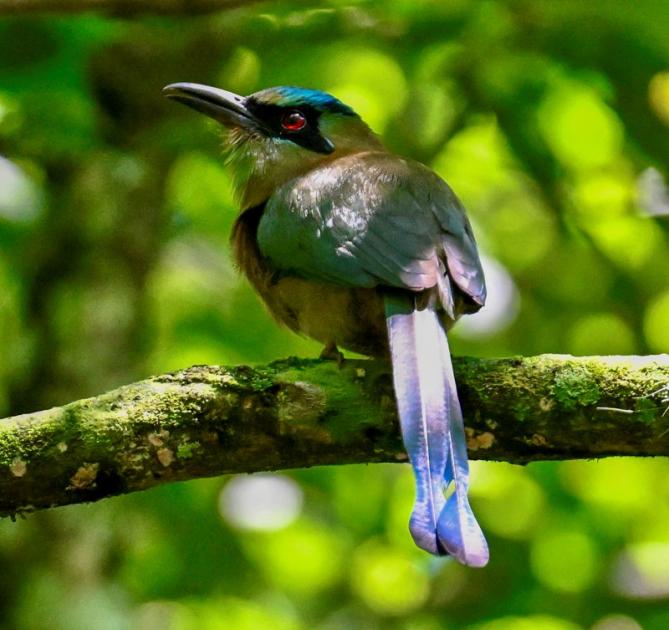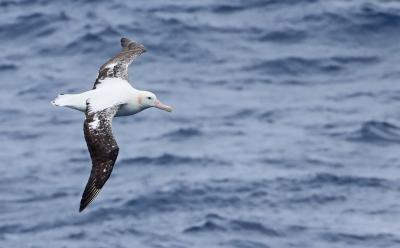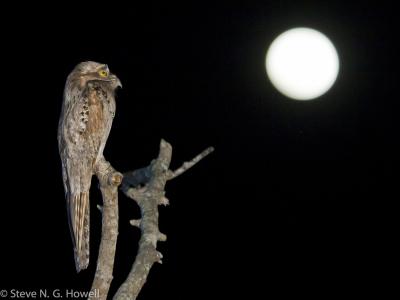Mexico: Veracruz
Migration is a Moving Experience
-
Sep 29 to Oct 7 2027
Steve Howell
Tour Price to be Determined
Tour Price to be Determined
Spanning from the warm waters of the Gulf of Mexico to the snow-capped volcano of Mount Orizaba, Mexico’s highest peak at 18,490 feet elevation, the state of Veracruz is home to an extremely diverse avifauna. Add to this the spectacle of fall migration, especially the world-famous ‘River of Raptors,’ and our short trip to sample this area makes for a memorable and remarkable experience.
Based out of only two hotels, we’ll divide our time between the coastal lowlands, where the local birds will compete for our attention amid the migrants, and the highlands of the Sierra Madre Oriental and Central Volcanic Belt, where coffee fincas grade into cloud forest and then cool fir forests on the higher slopes. From the recently split Veracruz Wren in coastal cactus to endemic Red Warblers flaunting their color in highland conifers, from tens—or even hundreds—of thousands of Broad-winged Hawks in a day to reclusive Blue-capped Motmots and Collared Towhees, this new trip is a great chance for a wonderful short getaway to the magic of Mexico.
Day 1: If time permits, after arrival we may do some birding on our hotel grounds, where species include Golden-fronted Woodpecker, Great Kiskadee, Yellow-winged Tanager, and even the recently established Monk Parakeet! Night in Veracruz.
Veracruz with Steve Howell was I believe my 12th Wings trip and I can easily say it was the birdiest. Whether it was the Broad-winged Hawk river in the sky, warblers in every tree and bush or 100’s of ducks fighting the wind over the ocean, there were so many birds. Mexico is a bird funnel for North American migrants in the fall. That said, it all depends on the weather, and we lucked out this year. - Kent A
Days 2–3: As with any migration tour, our daily plans will depend on the weather, but we’ll be checking beaches and coastal migrants traps for shorebirds and landbirds (sometimes including a pleasant variety of warblers, such as Mourning and Hooded), as well as relaxing in chairs to watch the raptor flights, which this early in the season are dominated by Broad-winged Hawks, with smaller numbers of Mississippi Kites, Turkey Vultures, and sundry other species. Resident birds of interest include Aplomado Falcon, Double-striped Thick-knee, Fork-tailed Flycatcher, and the recently split endemic Veracruz (née Rufous-naped) Wren, along with so-called South Texas specialties such as Brown Jay, Altamira Oriole, and Plain Chachalaca. Nights in Veracruz.
Days 4–7: We’ll spend another morning on the coastal plain and after lunch move inland to the state capital of Xalapa for four nights. From our base here we can explore pine-oak forest with flitting warbler flocks and skulking brushfinches; shady coffee-finca forest with Blue-capped Motmots and Bronze-winged Woodpeckers (plus a great diversity of colorful butterflies); plateau desert with thrashers, hummingbirds, and sparrows; and even high-elevation fir forest and bunch grass with resident (!) Golden-crowned Kinglets and the local endemic Striped Sparrow. Relict areas of drier grassy and scrub habitat are home to Mexican Sheartail, Botteri’s Sparrow, and the recently split Grass Wren, and anywhere we go we could run into southbound migrants, perhaps an Olive-sided Flycatcher sallying from a tall cactus, or a Canada Warbler sharing its tree with resident Crescent-chested and Olive Warblers. Nights in Xalapa.
Day 8: After a final morning of birding near Xalapa we’ll head back to the lowlands, stopping for any hawk flights, which by now will contain more Turkey Vultures and Swainson’s Hawks than only a week ago, and reaching our hotel in good time to rest and pack before a fine last dinner. Night in Veracruz.
Day 9: Depending on flight times, there may be opportunity for a little morning birding before transfer to the airport and flights homeward, after a rich and fun week exploring a tiny slice of Mexico.
Note: The information presented here is an abbreviated version of our formal General Information for Tours to Mexico: Veracruz. Its purpose is solely to give readers a sense of what might be involved if they take this tour. Although we do our best to make sure that what follows is completely accurate, it should not be used as a replacement for the formal document sent to all tour registrants, whose contents supersedes any information contained here.
ENTERING MEXICO: Mexico requires a valid passport for entry by US citizens. Citizens of other countries may need a visa and should check their nearest Mexican embassy. Your passport should be valid for at least six months after the date the tour ends. Tourist cards are required and are obtained upon entry at the border customs.
HEALTH: The Centers for Disease Control and Prevention (CDC) recommends that all travelers be up to date on routine vaccinations. These include measles-mumps-rubella (MMR) vaccine, diphtheria-tetanus-pertussis vaccine, varicella (chickenpox) vaccine, polio vaccine, and your yearly flu shot.
You can review the latest CDC advisories here.
PACE OF THE TOUR: As with all tours in the tropics, we’ll try to be in the field close to dawn which means about 6:15 a.m. The pace of each day varies somewhat with this tour: All breakfasts are at our hotel, typically picnic-style with a selection of yogurt, granola, fruits, and breads, plus juice and tea/coffee. Because of the high temperatures in the lowlands, lunches are at restaurants, although we plan one picnic lunches in the highlands if weather permits. All dinners are at restaurants. Walking is mostly along roads and wide trails that are level to gently sloping, with the option for some short stretches of steeper gradients. The highest elevation where we will be is around 10,000 feet (and walking slowly), but most of the time we’ll be around or below 7500 feet. Within the itinerary there are several afternoons where participants have the choice to relax at the hotel.
CLIMATE: Mexico’s climate is extremely variable. The lowlands around Veracruz, Cardel and Los Tuxtlas are humid and hot. Daytime highs could reach the mid-90°s F while in the lowlands. The highlands around Xalapa will be more comfortable, but early mornings may be cool enough for a jacket and sweater, and even gloves (as cool as the 40°s F). Rain is likely, and we highly recommend your bringing a travel umbrella.
ACCOMMODATIONS: All hotels offer standard facilities. All have AC. All hotels should have wifi, though strength of signal may vary. Hotel Mocambo in Veracruz has extensive grounds with birding potential, along with comfortable rooms, AC, and wifi. Hotel Fiesta Inn Xalapa is modern and comfortable with an excellent restaurant, wifi, and AC.
TRANSPORTATION: Transportation during the tour is by 10- or 15-passenger van/bus. All participants should have a window.
SMOKING: Smoking or vaping is prohibited in the vehicles or when the group is gathered for meals, checklists, etc. If you are sharing a room with a non-smoker, please do not smoke in the room. If you smoke in the field, we ask that you do so well away and downwind from the group, if possible.
TERMS AND CONDITIONS OF WINGS TOURS: Please take a moment to read the About WINGS Tours. This section contains important information about how we conduct tours, e.g., what is included in the tour price, refund and cancellation policies, pace of the tours, and other information that will help you prepare for the tour.
ADDITIONAL INFORMATION: A more complete General Information for Veracruz, Mexico, Tours will be sent to each registrant on receipt of their booking. Final information with instructions for meeting the group, hotel addresses, etc., will be mailed about three weeks before trip departure. Other news will be communicated as necessary. If you have any questions, please contact us.
2025 Narrative
Once again, this migration-centered tour was a great success, with a small group and fabulous birding, from quiet sandy beaches to cool montane conifer forests. Whether it was dizzying kettles of thousands of hawks or wave after wave of White-winged Doves and Scissor-tailed Flycatchers or a mixed flock with warblers, woodcreepers, trogons, vireos, and more, the great diversity of birdlife kept us busy—but in a good way. From flitting Red Warblers to fiery-eyed Curve-billed Thrashers; from sunlit Gray Silkies feeding on roadside berries to the undeniably ‘cute’ Tufted Flycatcher; from local endemics such as Strickland’s Woodpecker, Blue-capped Motmot, and Bearded Wood-Partridge to 28 species of warblers; from sun-downer beers to colorful butterflies in tropical shade-coffee forest; and from a cool sunny morning in high desert with singing thrashers to beaches with Reddish Egrets and Collared Plover it was a very special week, away from the madness of the so-called ‘developed’ world. The great range of habitats produced over 250 species in a week of unhurried birding, but all too soon it was over.
Everyone arrived safely into hot sunny weather, and early arrivals had time for a little birding near the hotel, where the recently established Monk Parakeets showed well, alongside Golden-fronted Woodpeckers, Great Kiskadees, numerous tail-less Great-tailed Grackles, and a notable fallout of migrant warblers. The intro meeting and dinner were followed for a good sleep. After an early breakfast, our first morning found us along a quiet beach road where swarm after swarm of migrating White-winged Doves passed over southward, along with flocks of Dickcissels and Scissor-tailed Flycatchers, and a scattering of other species ranging from White Ibis to Painted Bunting. Residents included some obliging Ferruginous Pygmy-Owls, the endemic Veracruz [Rufous-naped] Wren, and a handsome young male Barred Antshrike, while migrants ranged from Fulvous Whistling Duck to truly abundant Yellow-breasted Chats. Particularly notable was a LOW and BIG hawk flight right behind the beach, many thousands of Broad-winged Hawks (with up to five dark morphs in view at one time!) and hundreds of Mississippi Kites with smaller numbers of Turkey Vultures, Ospreys, Northern Harriers, and American Kestrels. The heat kicked in by mid-morning so we headed to the famous Cardel hawk migration watchpoint atop the Hotel Bienvenido, where Pronatura Veracruz is into its 35th year of counting the world famous ‘River of Raptors.’ Our timing was good: we stepped into the river mid-stream and before lunch had experienced tens of thousands of Broad-winged Hawks (almost 250,000 logged during the day!)—but much higher overhead (putting the speck into spectacle) than our earlier beach flight, along with kettles of Anhingas and sundry other species. After lunch and a welcome siesta we explored south of Veracruz City, where waterbirds included Reddish Egret and Black-necked Stilts in the surf along the beach, plus a dashing Merlin, our first Northern Jacanas and Limpkins, and a locally scarce Lark Sparrow.
Another early start took us to a different beach spot, where we soon appreciated the potential for great daily variation in migration—today no White-winged Doves! But by poking around we found a nice variety of waterbirds, headlined by the steadily declining Collared Plover, plus a textbook side-by-side comparison of Great Kiskadee with Boat-billed and Social Flycatchers, and a scattering of migrants. At another beach spot we enjoyed a roost with Sandwich Terns and Black Skimmers, before heading once more to Cardel—via stops to gasp at a spectacular hawk kettling flight right overhead along the highway! After a siesta we tried a new route and were rewarded with superb views of the understated Plain-breasted Ground Dove alongside a pair of Ruddy Ground Doves, fabulous but cryptic Double-striped Thick-knees, a Bare-throated Tiger Heron, and those amazing sunlit Purple Gallinules feeding up in grass stalks amid purple flowers! Not bad for a relaxed afternoon.
Our last lowland morning we visited a marshy savanna area south of Veracruz, which produced an exciting mix of birds that ranged from beautiful Aplomado Falcons to elegant Fork-tailed and Scissor-tailed Flycatchers side-by-side, plus more thick-knees, a massive Ringed Kingfisher, a Lesser Yellow-headed Vulture, a couple of late-migrating Purple Martins, and puzzling mockingbirds, including (presumed) hybrid Tropical x Northern. Then it was on to our base in Xalapa for the next four nights, at 1400 meters elevation and within easy reach of varied highland and foothill habitats. After a settling in and a siesta, our afternoon excursion to a relict patch of drier scrub paid off—finally—with nice views of the very local Mexican Sheartail (a male!), plus a swarming flock of Bronzed Cowbirds.
Our first ‘highland’ day we birded an area of shade coffee surrogate forest, rich in birds and even more so in spectacular butterflies. Azure-crowned Hummingbirds proved common, and the striking switch from Yellow Warblers of previous days to Wilson’s Warblers for the coming days indicated our shift from tropical to subtropical environments. Great looks at Common Squirrel Cuckoos and Montezuma Oropendolas were enjoyed, and with some patience we also found the local endemic Blue-capped Motmot and ‘Bronze-winged’ Woodpecker (aka Golden-olive Woodpecker) before becoming distracted by a wealth of colorful butterflies. A pleasant relaxing lunch overlooking the spectacular Teocelo waterfall was followed by an encounter with a truly huge and nightmarish ‘demon beetle’ before we headed back for a siesta. In late afternoon we sampled some relict native grassland and scrub, where birds included Botteri’s Sparrow, cute Black-crested Titmouses/Titmice, and a surprise Say’s Phoebe.
Our first true highland day started out decidedly cold, but then the sun soon warmed things up. We began in cloud forest at Las Minas, where Bearded Wood-Partridges and a Barred Forest Falcon called from below us in the canyon as White-throated Swifts zipped overhead, and beautiful sunlit Gray Silkies (aka Silky-flycatchers) fed in roadside trees. Other notables included Elegant Euphonia, Bumblebee Hummingbird, juvenile Cinnamon-bellied Flowerpiercers, perky Mexican Chickadees, and a juvenile White-throated Flycatcher. Moving to higher elevation on Cofre de Perote we enjoyed a picnic lunch in cool fir forest full of the vocally distinct local Golden-crowned Kinglets before the cloud reduced visibility to 100 feet! Fortunately a short drop in elevation brought us back into sun, where we found Transvolcanic (née Mexican) Jays, Striped Sparrow, and an educational but sadly deceased roadkill Collared Towhee x Spotted Towhee hybrid. But still no Red Warblers... Our last stop started out quietly, but then a Strickland’s Woodpecker led us to some White-breasted Nuthatches and a Pine Flycatcher, and an Olive Warbler, and, finally, an 11th-hour stunning Red Warbler, which rounded out a full day.
The second highland day we started in the cool valley floor near Perote, with fiery-eyed Curve-billed Thrashers, before ascending into sun-bathed hillsides of Joshua tree desert, a very different habitat from the rest of the tour. Morning birds ranged from Woodhouse’s Scrub Jays eating cactus fruits to a preening adult with juvenile Ocellated Thrasher, plus Lucifer Hummingbirds, Rock Wren, Loggerhead Shrike, and the recently split Lilian’s (aka Chihuahuan) Meadowlark. After a filling roadside lunch stop we birded in some pine-oak forest where persistence was rewarded with a flock that included a stunning male Mountain Trogon, cute Tufted Flycatcher, and Spot-crowned Woodcreepers, plus sundry vireos and warblers. Our last stop in a relict cloud forest reserve was quiet, as expected in late afternoon, but still produced a nice little Olivaceous Woodcreeper, two bizarre Caca de Luna aggregations, and some impressive tree ferns. Just another diverse day of birding in Mexico.
The next morning we revisited the cloud forest near Xalapa and enjoyed a relaxed walk through the beautiful forest, along with a great diversity of birds, starting with White-naped Brushfinch and ending with Blue-capped Motmot. ‘In-between’ highlights included Collared and Gartered Trogons, Berylline Hummingbird, Brown-capped Vireo, Acorn Woodpeckers, and numerous warblers including migrant Louisiana Waterthrushes and a nice Blue-winged along with resident Golden-crowned, Golden-browed, and Rufous-capped. After lunch we visited the raptor observatory at Chichicaxtle for some shopportunities and information about Pronatura’s long-term monitoring work. Relaxing on chairs in the shade was a nice way to wind down the tour as Blue-gray and Yellow-winged Tanagers showed in the eye-level flowers, but sadly the weather was not conducive to a good raptor flight.
Flight times allowed a little time for last morning birding near the hotel, but all too soon it was time to leave, after a great week of migration, from beaches to mountains; plus numerous resident bird species, friendly people, fine company, and delicious cuisine. Thanks to all for making this a wonderful trip.
- Steve Howell
Veracruz with Steve Howell was I believe my 12th Wings trip and I can easily say it was the birdiest. Whether it was the Broad-winged Hawk river in the sky, warblers in every tree and bush or 100’s of ducks fighting the wind over the ocean, there were so many birds. Mexico is a bird funnel for North American migrants in the fall. That said, it all depends on the weather, and we lucked out this year.
- Kent A. on Mexico: Veracruz
Maximum group size seven with one leader; 10 with two leaders.

























